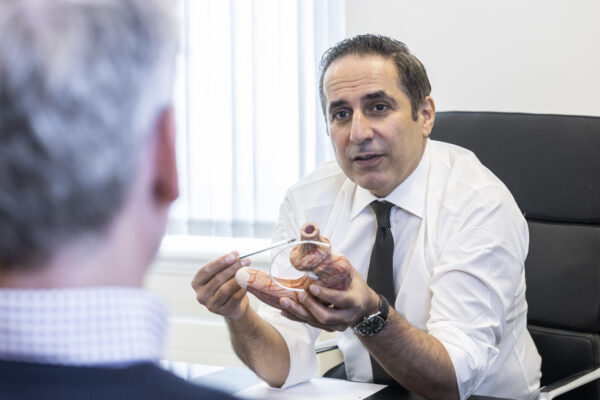Contact number: 020 7806 4060
What is the LINX system?
The Linx System is suitable for chronic GORD sufferers who do not respond fully to medication.
The LINX System is a medical device which is placed around the Lower Oesophageal Sphincter (LOS) using a simple technique called laparoscopy (keyhole surgery). The device consists of a small flexible band of interlinked titanium beads with magnetic cores and is placed around the LOS in the closed position. The beads will separate temporarily as the force a swallow allows good and drink to pass into the stomach. The magnetic attraction between the beads then brings the device back to the closed position to prevent reflux occurring. The magnets are calibrated to allow higher gastric pressures to open the device, but will not open for the lower gastric pressure of reflux.
Private LINX System surgery in London
In cases of GORD that cannot be treated by medication, individuals may be referred to a reflux surgeon who may recommend you have a LINX system fitted.
At St John & St Elizabeth Hospital, The LINX System performed laparoscopically (keyhole) and are designed to relieve your symptoms, prevent further damage, as well as allow you to come off medication. If surgery looks like the best option to stop your symptoms, the team here has been offering advanced surgery for GORD for over 20 years, and will support you every step of the way.
If you are struggling with acid reflux, or think that you might be experiencing symptoms of GORD, get in touch with our specialist reflux team.
How to pay for your treatment
If you’re… paying for yourself
Did you know you don’t need private medical insurance to come to St John & St Elizabeth Hospital? As a self-pay patient, you can access safe, outstanding quality health care at times to suit you.
For scans and tests, as well as to see most consultants, you’ll still need to be referred by a medical professional like your GP, but as a self-pay patient, the process is more straightforward. You won’t need authorisation from an insurance provider, and you’ll have greater choice of consultant and appointment times.
If you’re… insured
St John & St Elizabeth Hospital is approved by all major medical insurance companies. If you have a personal private health insurance policy, or your company provide it for you, you can use it to pay for your care from your initial consultation through to treatment, surgery and aftercare such as physiotherapy.
Not all private health insurance plans cover the same things. It’s very important to check exactly what you are covered for with your insurance provider.
Frequently asked questions about The LINX System
St John & St Elizabeth Hospital is located in St John’s Wood (NW8), a well-connected and vibrant area of North West London, known for landmarks such as Regent’s Park and Abbey Road Studios. We are easily accessible from neighbouring areas, including Hampstead (NW3) and Kilburn (NW6):
- By Tube: St John’s Wood station (Jubilee Line) is just a 5-minute walk from the hospital. For patients travelling from Hampstead (NW3), Finchley Road station (Jubilee Line) offers a convenient route, while Kilburn (NW6) is similarly well served by the same line.
- By Bus:
Wellington Road: Routes 13, 46, 82, and 113 stop near St John’s Wood Underground Station, just a short walk from the hospital.
Circus Road: Routes 46 and 187 stop close to the hospital’s Circus Road entrance.
Abbey Road: Routes 139 and 189 stop near the junction where Grove End Road becomes Abbey Road, providing easy access.
- By Car: If you’re travelling from NW3 or NW6, use major roads like Finchley Road or Kilburn High Road for a direct approach.
Our hospital’s location in St John’s Wood ensures easy access for patients across London, particularly from the NW8, NW3, and NW6 postcodes.
A clinical study looked at the extent to which the LINX System had helped patients five years after it had been implanted. The results showed that the GORD symptoms had improved significantly, and that 85% of patients were able to stop daily PPI medication. Reassuringly, these patients also said their quality of life had improved.
The Linx System is not suitable for every patient with reflux. It is suitable for people who have suffered from GORD for a number of years, who respond partially to medication. In addition, the individual should be able to swallow normally and have a healthy oesophagus.
Patients are assessed for their eligibility following a series of tests including pH Monitoring and Manometry.
An endoscopy examination using a thin, flexible telescope passed down the oesophagus into the stomach will give the specialist an accurate indication of the health of your oesophagus.
If reflux oesophagitis is suspected during endoscopy, then several small biopsies are taken from the lining of the oesophagus to determine the severity of the condition.
On rare occasions, specialised acid measurement tests are needed to confirm the diagnosis. Doctors can also ask for a barium swallow or barium meal that uses a solution and X-rays to chart blockages or abnormalities in the oesophagus.
The main symptom of gastroesophageal disease is heartburn but you can also feel pain in the upper abdomen or chest. Patients can feel sick and experience acid reflux where stomach acid comes back into your mouth causing an unpleasant, sour taste.
Other symptoms are belching, a burning pain when swallowing hot drinks and bad breath. Symptoms usually occur after a large meal, or at night and may feel worse when you are lying flat.
Medically reviewed by Mr Majid Hashemi - MB ChB FRCS (Gen) on 30/11/2024


